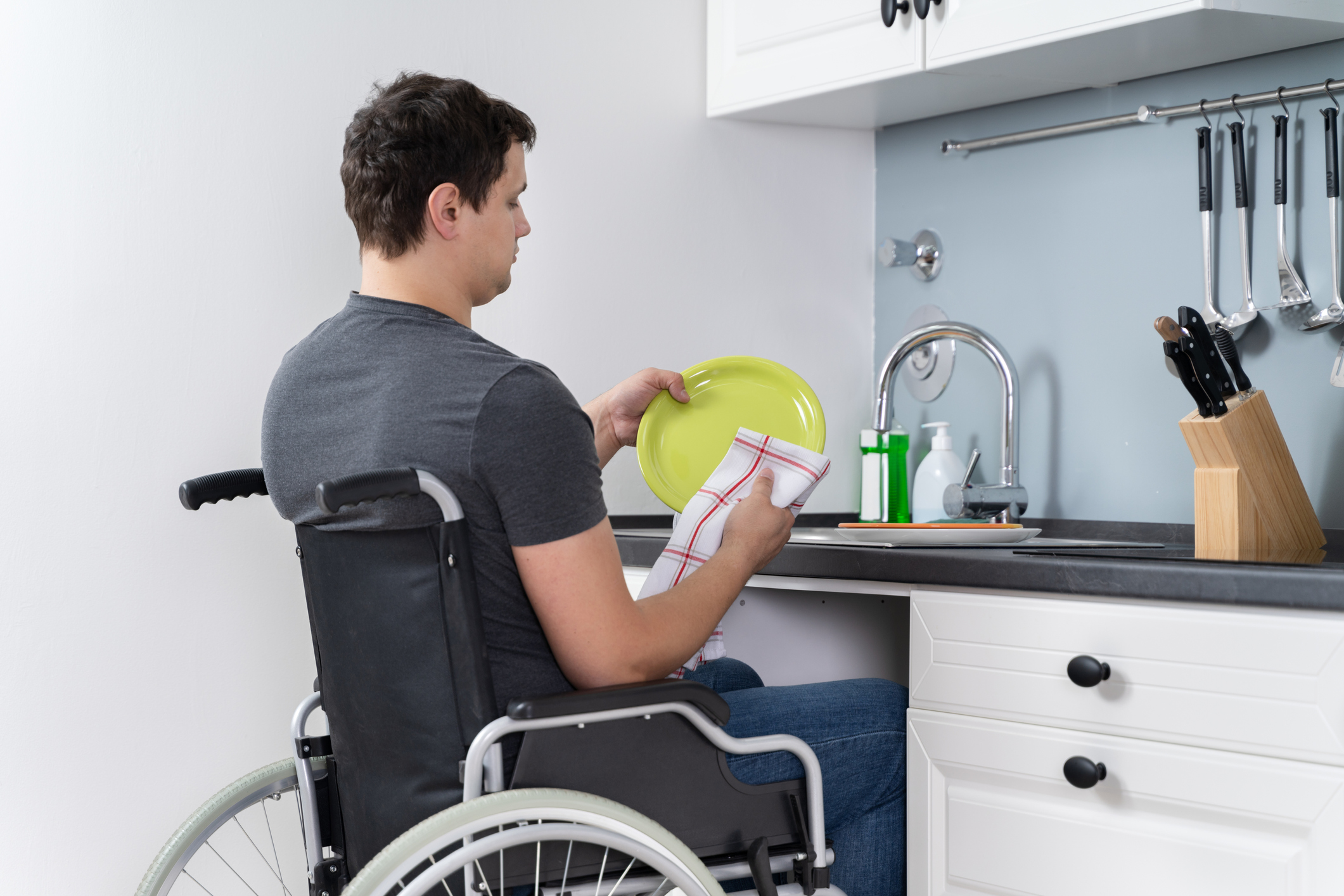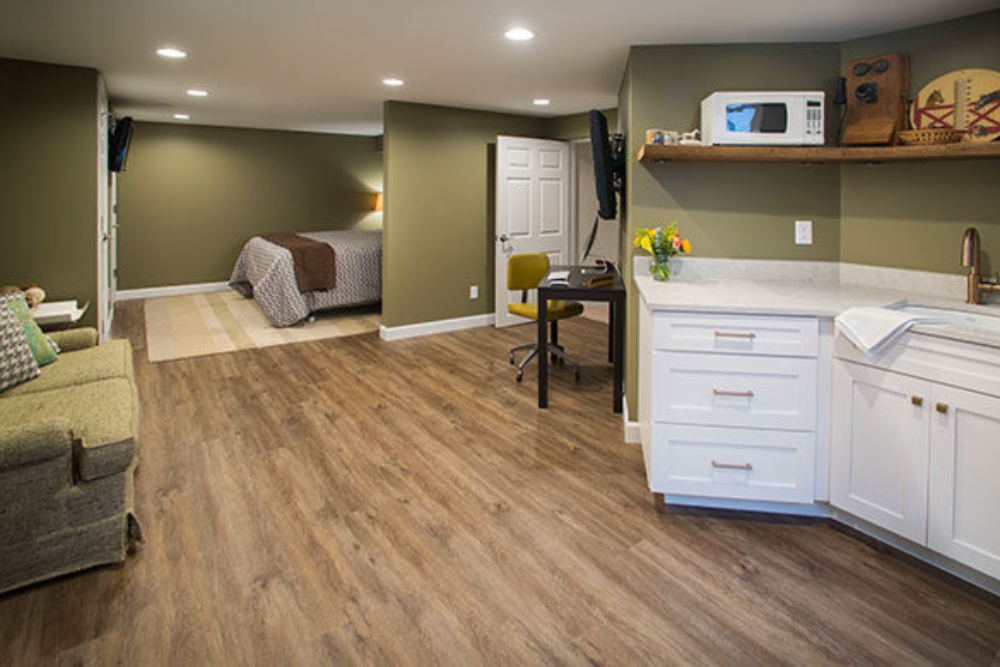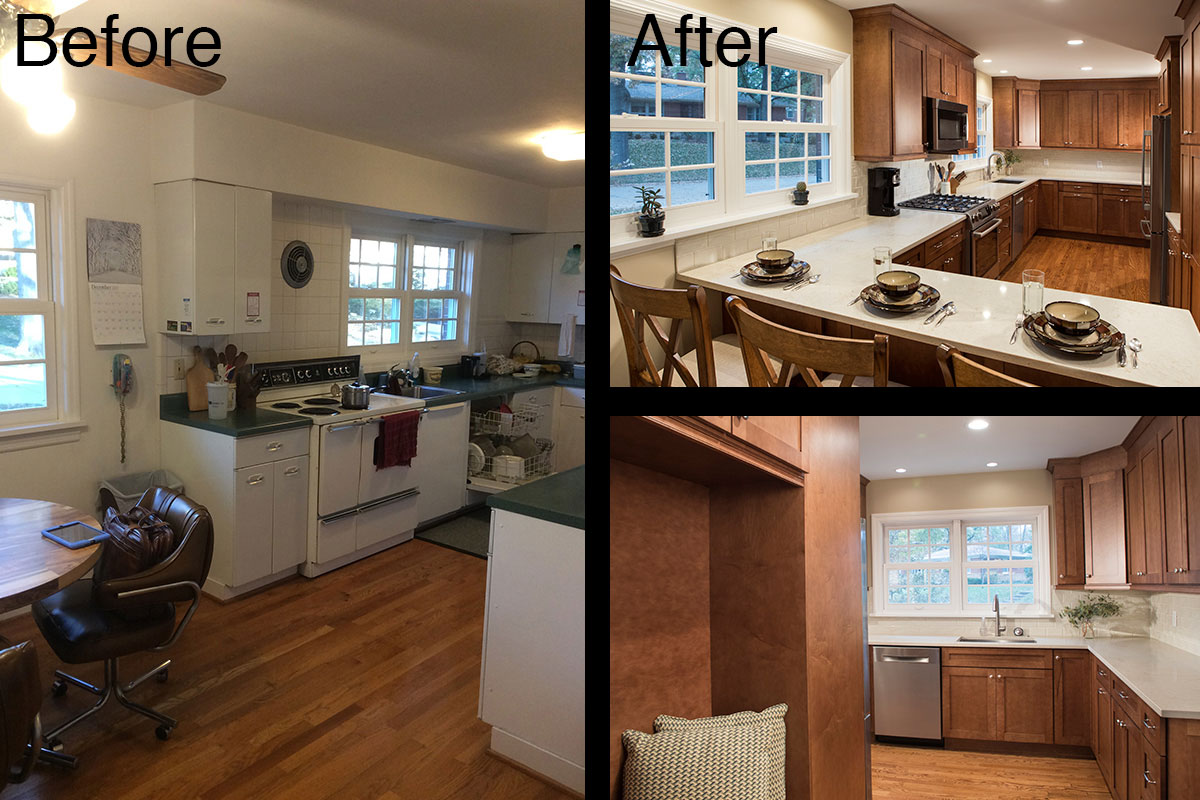
As we age as a society, and more and more of us are choosing to age at home, creating a safe, comfortable, and functional living space is becoming increasingly important. For many seniors, the heart of the home is the kitchen, where meals are prepared, conversations are shared, and memories are made. Designing an aging in place kitchen is a thoughtful and practical approach to ensuring that not just your kitchen, but your home, remains a welcoming and accessible space as you grow older. Roeser Home Remodeling understands the unique needs of homeowners looking to create an aging in place kitchen that they can use safely and comfortably. We’ve won awards for creating aging in place spaces for clients across the St. Louis area. In the future, we will discuss more aging in place spaces. This month, we will be discussing the many features of an aging-in-place-friendly kitchen.
Let’s take a look at the key considerations, features, and design principles for crafting a kitchen that promotes independence, safety, and convenience for seniors. This is a list-heavy blog, but we feel that breaking the information down is important when considering important subjects like aging at home.
The Importance of an Aging in Place Kitchen
Aging in place refers to the ability to live independently and comfortably in one’s own home as one gets older. The kitchen is a critical area where aging in place can be challenging due to its potential hazards and physical demands. Designing an aging in place kitchen is an investment in your future well-being and allows you to:
- Maintain Independence: An accessible kitchen empowers seniors to continue cooking, preparing meals, and managing their daily routines independently.
- Enhance Safety: By minimizing potential hazards and creating a user-friendly layout, an aging in place kitchen reduces the risk of accidents and injuries, such as slips and falls.
- Promote Comfort: Comfortable and well-designed kitchens can alleviate physical strain, making everyday tasks more manageable and enjoyable.
- Adapt to Changing Needs: An aging in place kitchen anticipates future needs, allowing for easy adjustments and accommodating changing mobility and health conditions.
Universal Design Principles
Universal design is a philosophy that focuses on creating spaces and products that are usable by people of all ages and abilities. Incorporating universal design principles into your aging in place kitchen ensures that it is accessible and convenient for everyone. Roeser Home Remodeling will discuss these principles with you when we come over to discuss what you want. Key principles include:
- Zero-step entries: Eliminate any steps or thresholds at the entrance to the kitchen to facilitate easy access, especially for those using mobility aids.
- Wide doorways: Ensure that doorways are wide enough to accommodate wheelchairs or walkers comfortably.
- Non-slip flooring: Choose slip-resistant flooring materials to reduce the risk of falls. Smooth, low-pile flooring is easier to maneuver on and clean.
- Lever handles and faucets: Install lever-style door handles and faucets, which are easier to grip and operate for individuals with arthritis or limited hand strength.
- Task lighting: Adequate lighting is essential. Incorporate task lighting under cabinets and inside drawers to illuminate work areas and make it easier to find items.
- Contrasting colors: Use contrasting colors for countertops, cabinets, and appliances to aid individuals with visual impairments in distinguishing between different elements in the kitchen.

Accessible Layout and Workspaces
An efficient and accessible layout is a cornerstone of an aging in place kitchen. Consider the following design elements:
- Clear pathways: Ensure there are clear, wide pathways between countertops, appliances, and work areas to accommodate mobility aids and prevent tripping hazards.
- Lowered countertops: Incorporate countertops at varying heights, including lowered areas for seated food preparation and workstations for individuals in wheelchairs.
- Pull-out shelves and drawers: Replace traditional cabinets with pull-out shelves and drawers for easier access to pots, pans, and pantry items.
- Induction cooktops: Induction cooktops are safer and more energy-efficient, as they don’t have open flames or hot surfaces. They are also easier to clean.
- Raised appliances: Raise dishwashers, ovens, and microwaves to a comfortable height to reduce bending and stooping.
- Aisle clearance: Maintain at least 42 inches of clearance between countertops and islands for easy maneuverability.
Appliance Selection
Choosing the right appliances is essential for an aging in place kitchen. Opt for appliances that are user-friendly and accommodate changing needs:
- Side-by-side refrigerator: A refrigerator with a side-by-side design provides easy access to both the freezer and refrigerator compartments without excessive bending or reaching.
- Wall ovens: Wall ovens are typically positioned at eye level, making it easier to load and unload dishes and reducing the risk of burns or spills.
- Drawer-style dishwashers: Drawer-style dishwashers are more accessible and allow for smaller loads when necessary.
- Pull-out pantry: Install pull-out pantry shelves to provide easy access to food items without the need for excessive reaching and stretching.
Flooring and Surfaces
Selecting the right flooring and surfaces is crucial for safety and comfort. This cannot be emphasized enough. Falling is one of the most common reasons older people lose the ability to live independently. This is a subject we feel strongly about and we will help you choose flooring that will both add to the aesthetic of your home and help you remain safe.
- Non-slip flooring: Choose flooring materials with a non-slip surface, such as textured tiles, linoleum, or cork, to reduce the risk of accidents.
- Low-maintenance surfaces: Opt for easy-to-clean countertops and backsplashes that require minimal maintenance.
- Rounded edges: Select countertops with rounded edges to prevent injuries from sharp corners.
- Anti-scald faucets: Install anti-scald faucets to regulate water temperature and prevent burns.
Storage Solutions
Effective storage solutions are essential for maintaining an organized and clutter-free aging in place kitchen:
- Pull-out cabinets: Replace traditional cabinets with pull-out shelves, drawers, and trays to maximize accessibility.
- Lazy Susans: Lazy Susans can be installed in corner cabinets to provide easy access to items that would otherwise be challenging to reach.
- Adjustable shelving: Install adjustable shelves in cabinets and pantries to accommodate changing storage needs.
- Clear containers: Use clear containers for pantry items to make it easier to identify and access ingredients.
Lighting
Proper lighting is essential for safety and visibility in an aging in place kitchen:
- Task lighting: Install task lighting under cabinets to illuminate countertops and work areas effectively.
- Motion-activated lighting: Consider motion-activated lighting in pantries, cabinets, and drawers that will automatically illuminate spaces when they are opened.
- Natural light: Maximize natural light with well-placed windows or skylights to reduce the reliance on artificial lighting during the day.

Accessible Faucets and Fixtures
Choose faucets and fixtures that are easy to operate, even for individuals with limited dexterity:
- Single-lever faucets: Install single-lever faucets that require minimal effort to adjust water temperature and flow.
- Hands-free faucets: Hands-free faucets with motion sensors are a convenient option for individuals who have difficulty turning knobs.
- Pull-down sprayers: Faucets with pull-down sprayers provide flexibility and ease of use for washing dishes and filling pots.
Grab Bars and Handrails
Incorporate grab bars and handrails in strategic locations to provide support and stability. The last thing you want to do is slip and fall while you’re holding a hot pan or a full pot.
- Near the sink: Install grab bars near the sink to assist with tasks like washing dishes or preparing food.
- Around the stove: Position grab bars near the stove to provide support while cooking.
- In the pantry: Place handrails in the pantry to aid in reaching high or low shelves.
- Near transitions: Install handrails near any transitions between rooms to prevent slips and falls.
Closing Thoughts
Designing an aging in place kitchen is a proactive and thoughtful approach to ensuring that your kitchen remains a safe, comfortable, and functional space as you grow older. At Roeser Home Remodeling in Kirkwood, Missouri, we are committed to helping homeowners create kitchens that promote independence, safety, and convenience for seniors. By incorporating universal design principles, accessible layouts, the right appliances, storage solutions, and thoughtful lighting, you can transform your kitchen into a space that supports your changing needs and allows you to continue enjoying the heart of your home for years to come. Contact Roeser Home Remodeling today to discuss your vision for an aging in place kitchen, and let us help you create a kitchen that meets your unique requirements while maintaining style and functionality.
Who We Are and Why You Should Love Us!
For over thirty years, Roeser Home Remodeling has been in the business of helping homeowners design closets that meet their needs and match their lifestyles.
The Staff at Roeser Home Remodeling brings the same expectations to every job—quality, customer satisfaction, and integrity. You will always get our best, without fail. Our goal is to make the entire process as easy as possible while still giving the client the high-quality results they deserve.
We are the recipient of several awards, including the Aging in Place Remodeling Project of the Year by the HBA of St. Louis, as well as the Best Houzz of 2020. Our Director of Design, Brandi Ward, has won several awards for her kitchen designs, and recently accepted one from ShowPlace Cabinets for her beautiful kitchen design. Brandi is an expert in creating functional kitchen layouts for families!
We are members of the Home Builders Association of St Louis, which shows our willingness to be held accountable for the quality of our work. Roeser Home Remodeling uses only the best materials, including products like Wellborn Cabinets and Showplace Cabinets. And we have an A+ rating with BBB.
Want to know more? Check out our portfolio and give us a call!
